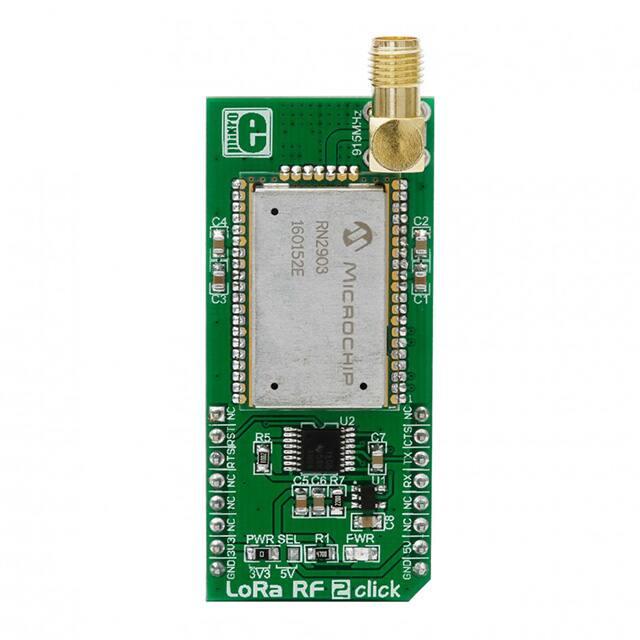Page 1 of 2
Lora 2 click
From MikroElektonika Documentation
LoRa 2 click carries Microchip’s RN2903 915 MHz Radio Modem compliant
with regulations for use in the United States, Canada, Australia and New Zealand.
Lora 2 click
Features and usage notes
Study the data sheet before
applying either Lora or Lora 2
click in your designs. It is your
responsibility to get acquinted
with relevant regulations of
radio frequency use.
For example, here's what the
official data sheet states about
compliance with USA
regulations: "the RN2903
module has received Federal
Communications Commission
Schematic also available in PDF (http://cdn(FCC) CFR47
docs.mikroe.com/images/d/d5/Lora_2_click_schemat
Telecommunications, Part 15
Subpart C “Intentional
Radiators” modular approval in accordance with Part 15.212 Modular Transmitter
approval. Modular approval allows the end user to integrate the RN2903 module
into a finished product without obtaining subsequent and separate FCC approvals
for intentional radiation, provided no changes or modifications are made to the
module circuitry."
Lora 2 click
IC/Module RN2903
(http://ww1.microchip.com/downloads/en/DeviceDoc/50002390B.pdf)
Interface
UART
Power
3.3V, 5V
supply
On the other hand, in New Zealand, it would be your responsibility to prove the
Website
www.mikroe.com/click/lora-2 (http://www.mikroe.com/click/lora-2)
device is compliant. To quote from the data sheet: "RN2903 module RF transmitter
test reports can be used in part to demonstrate compliance against the New Zealand
"General User Radio License for Short Range Devices". New Zealand Radio communications (Radio Standards) Notice 2010 calls up the AS / NZS 4268:2008
industry standard. The RN2903 module test reports can be used as part of the product certification and compliance folder."
You can find all the relevant data on page 13 of the official data sheet.
The RN2903 module on Lora 2 click has a specified range of >15km in rural and suburban settings, and >5km coverage in urban areas. A LoRaWAN™ Class A
protocol stack is embedded (bidirectional end devices), as well as an ASCII command interface accessible through UART. The high receiver sensitivity can go
down to -146 dBm. LoRa click communicates with the target board MCU through the mikroBUS™ UART interface (CTS, TXD, RXD), with the addition of a
Reset pin (RST) and RTS. The board is designed to use either a 3.3V or a 5V power supply. NOTE: antenna sold separately.
A version of Lora click compliant with European wireless regulations is also available. See Lora click (http://www.mikroe.com/click/lora)
Programming
LoRa process must be kept inside an infinite loop
1 while( 1 )
2 {
lora_rf_process();
3
4 }
Code examples that demonstrate the usage of Lora 2 click with MikroElektronika hardware, written for MikroE compilers are available on Libstock
(http://libstock.mikroe.com/projects/view/1861/mcp25625-click).
Resources
- Vendor’s data sheet (http://ww1.microchip.com/downloads/en/DeviceDoc/50002390B.pdf)
- Learn article about Lora 2 click (http://learn.mikroe.com/lora-2)
- mikroBUS™ standard specifications (http://download.mikroe.com/documents/standards/mikrobus/mikrobus-standard-specification-v200.pdf)
Retrieved from "http://docs.mikroe.com/index.php?title=Lora_2_click&oldid=552"
�Page 2 of 2
◾ This page was last modified on 27 July 2016, at 17:20.
◾ Content is available under Creative Commons Attribution unless otherwise noted.
http://docs.mikroe.com/index.php?title=Lora_2_click&printable=yes
8/8/2016
�
很抱歉,暂时无法提供与“MIKROE-2225”相匹配的价格&库存,您可以联系我们找货
免费人工找货